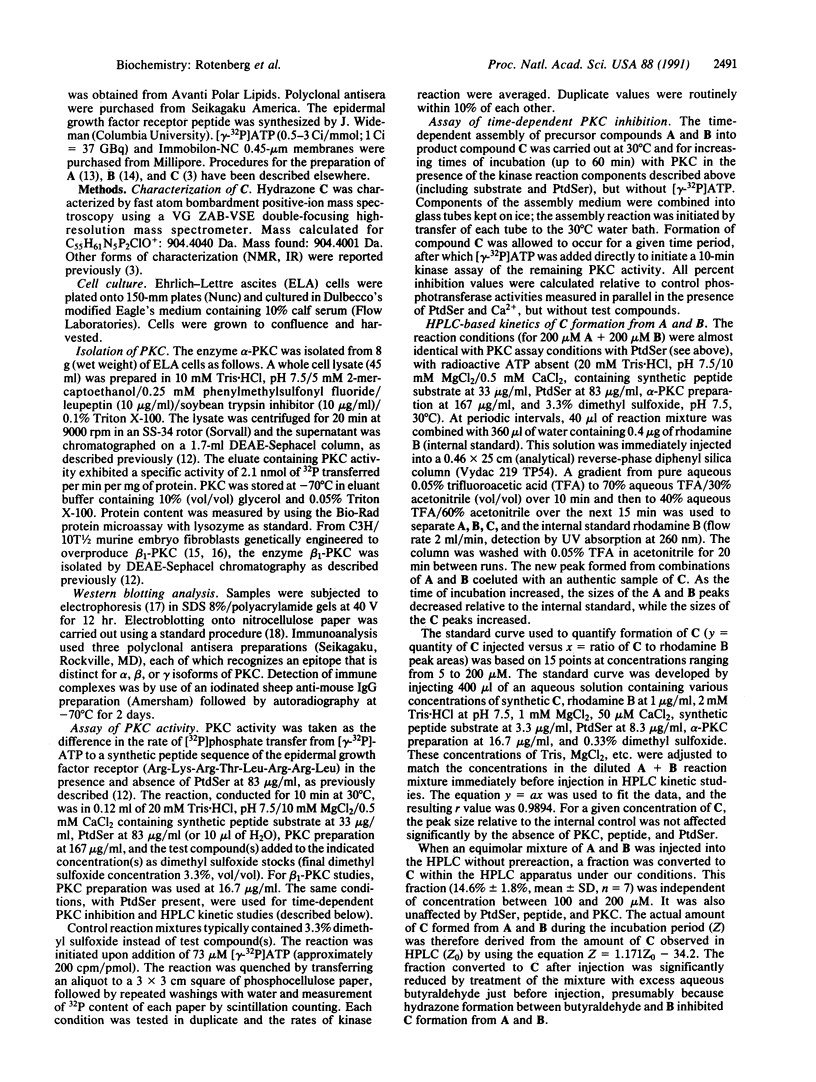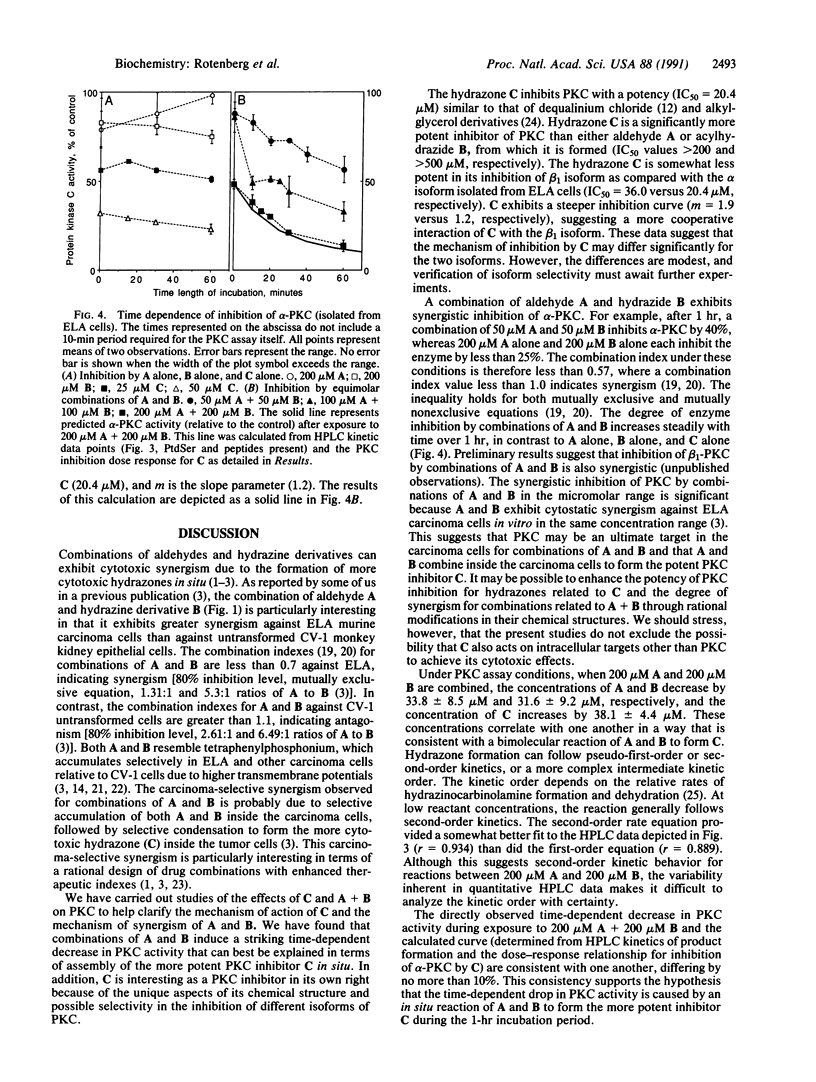Abstract
Previous studies have described a dicationic anticarcinoma agent that can chemically assemble in situ from monocationic phosphonium salts. The chemical combination of these monocationic precursors in the micromolar concentration range, occurring after their uptake by cells, was probably responsible for their synergistic inhibition of cell growth and for their selective cytotoxicity to Ehrlich ascites murine carcinoma cells relative to untransformed epithelial cells. Here, we report that the dicationic product that forms in this assembly reaction is an in vitro inhibitor of protein kinase C (PKC) alpha and beta 1 isoforms, exhibiting IC50 values of 20.4 microM and 35 microM, respectively. The monocationic precursors proved to be much weaker inhibitors of PKC (IC50 values greater than 200 microM). When PKC is exposed to combinations of the two precursors, the enzymatic activity decreases steadily as a function of time. Using dose-response data and HPLC kinetic studies, we show that when the two precursor compounds are added as a combination to PKC under these conditions, the rate of formation of the inhibitory product follows the observed time course of decline in PKC activity under identical conditions. We discuss the possibility that antiproliferative effects against carcinoma cells of the preformed dication and of the combined monocationic precursors involve inhibition of PKC.
Full text
PDF




Selected References
These references are in PubMed. This may not be the complete list of references from this article.
- Davis S., Weiss M. J., Wong J. R., Lampidis T. J., Chen L. B. Mitochondrial and plasma membrane potentials cause unusual accumulation and retention of rhodamine 123 by human breast adenocarcinoma-derived MCF-7 cells. J Biol Chem. 1985 Nov 5;260(25):13844–13850. [PubMed] [Google Scholar]
- Grunicke H., Hofmann J., Maly K., Uberall F., Posch L., Oberhuber H., Fiebig H. The phospholipid- and calcium-dependent protein kinase as a target in tumor chemotherapy. Adv Enzyme Regul. 1989;28:201–216. doi: 10.1016/0065-2571(89)90072-1. [DOI] [PubMed] [Google Scholar]
- Huang K. P., Huang F. L., Nakabayashi H., Yoshida Y. Biochemical characterization of rat brain protein kinase C isozymes. J Biol Chem. 1988 Oct 15;263(29):14839–14845. [PubMed] [Google Scholar]
- Krauss R. S., Housey G. M., Johnson M. D., Weinstein I. B. Disturbances in growth control and gene expression in a C3H/10T1/2 cell line that stably overproduces protein kinase C. Oncogene. 1989 Aug;4(8):991–998. [PubMed] [Google Scholar]
- Laemmli U. K. Cleavage of structural proteins during the assembly of the head of bacteriophage T4. Nature. 1970 Aug 15;227(5259):680–685. doi: 10.1038/227680a0. [DOI] [PubMed] [Google Scholar]
- Lampidis T. J., Hasin Y., Weiss M. J., Chen L. B. Selective killing of carcinoma cells "in vitro" by lipophilic-cationic compounds: a cellular basis. Biomed Pharmacother. 1985;39(5):220–226. [PubMed] [Google Scholar]
- Marasco C. J., Jr, Piantadosi C., Meyer K. L., Morris-Natschke S., Ishaq K. S., Small G. W., Daniel L. W. Synthesis and biological activity of novel quaternary ammonium derivatives of alkylglycerols as potent inhibitors of protein kinase C. J Med Chem. 1990 Mar;33(3):985–992. doi: 10.1021/jm00165a016. [DOI] [PubMed] [Google Scholar]
- Nishizuka Y. Studies and perspectives of protein kinase C. Science. 1986 Jul 18;233(4761):305–312. doi: 10.1126/science.3014651. [DOI] [PubMed] [Google Scholar]
- Nishizuka Y. The molecular heterogeneity of protein kinase C and its implications for cellular regulation. Nature. 1988 Aug 25;334(6184):661–665. doi: 10.1038/334661a0. [DOI] [PubMed] [Google Scholar]
- Nishizuka Y. The role of protein kinase C in cell surface signal transduction and tumour promotion. Nature. 1984 Apr 19;308(5961):693–698. doi: 10.1038/308693a0. [DOI] [PubMed] [Google Scholar]
- Rideout D. C., Calogeropoulou T., Jaworski J. S., Dagnino R., Jr, McCarthy M. R. Phosphonium salts exhibiting selective anti-carcinoma activity in vitro. Anticancer Drug Des. 1989 Dec;4(4):265–280. [PubMed] [Google Scholar]
- Rideout D., Calogeropoulou T., Jaworski J., McCarthy M. Synergism through direct covalent bonding between agents: a strategy for rational design of chemotherapeutic combinations. Biopolymers. 1990 Jan;29(1):247–262. doi: 10.1002/bip.360290129. [DOI] [PubMed] [Google Scholar]
- Rideout D., Jaworski J., Dagnino R., Jr Environment-selective synergism using self-assembling cytotoxic and antimicrobial agents. Biochem Pharmacol. 1988 Dec 1;37(23):4505–4512. doi: 10.1016/0006-2952(88)90666-1. [DOI] [PubMed] [Google Scholar]
- Rideout D. Self-assembling cytotoxins. Science. 1986 Aug 1;233(4763):561–563. doi: 10.1126/science.3523757. [DOI] [PubMed] [Google Scholar]
- Rotenberg S. A., Krauss R. S., Borner C. M., Weinstein I. B. Characterization of a specific form of protein kinase C overproduced by a C3H 10T1/2 cell line. Biochem J. 1990 Feb 15;266(1):173–178. doi: 10.1042/bj2660173. [DOI] [PMC free article] [PubMed] [Google Scholar]
- Rotenberg S. A., Smiley S., Ueffing M., Krauss R. S., Chen L. B., Weinstein I. B. Inhibition of rodent protein kinase C by the anticarcinoma agent dequalinium. Cancer Res. 1990 Feb 1;50(3):677–685. [PubMed] [Google Scholar]
- Towbin H., Staehelin T., Gordon J. Electrophoretic transfer of proteins from polyacrylamide gels to nitrocellulose sheets: procedure and some applications. Proc Natl Acad Sci U S A. 1979 Sep;76(9):4350–4354. doi: 10.1073/pnas.76.9.4350. [DOI] [PMC free article] [PubMed] [Google Scholar]
- Weinstein I. B. Strategies for inhibiting multistage carcinogenesis based on signal transduction pathways. Mutat Res. 1988 Dec;202(2):413–420. doi: 10.1016/0027-5107(88)90202-3. [DOI] [PubMed] [Google Scholar]
- Weinstein I. B. The origins of human cancer: molecular mechanisms of carcinogenesis and their implications for cancer prevention and treatment--twenty-seventh G.H.A. Clowes memorial award lecture. Cancer Res. 1988 Aug 1;48(15):4135–4143. [PubMed] [Google Scholar]
- Weiss M. J., Wong J. R., Ha C. S., Bleday R., Salem R. R., Steele G. D., Jr, Chen L. B. Dequalinium, a topical antimicrobial agent, displays anticarcinoma activity based on selective mitochondrial accumulation. Proc Natl Acad Sci U S A. 1987 Aug;84(15):5444–5448. doi: 10.1073/pnas.84.15.5444. [DOI] [PMC free article] [PubMed] [Google Scholar]


